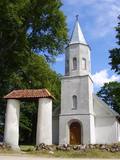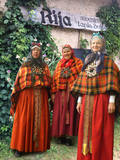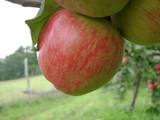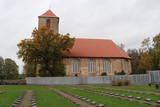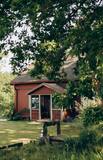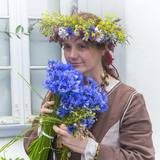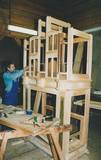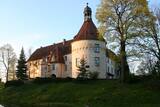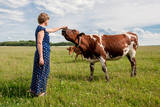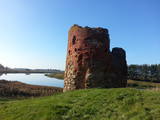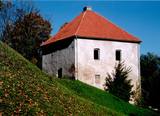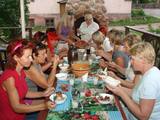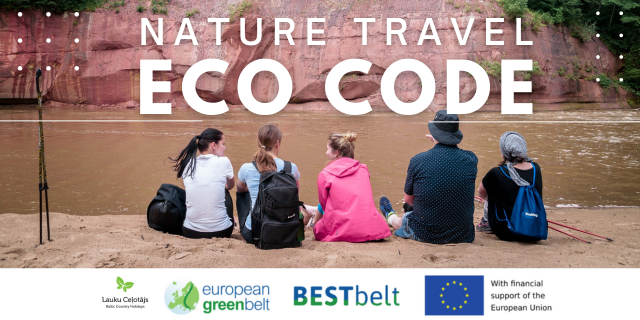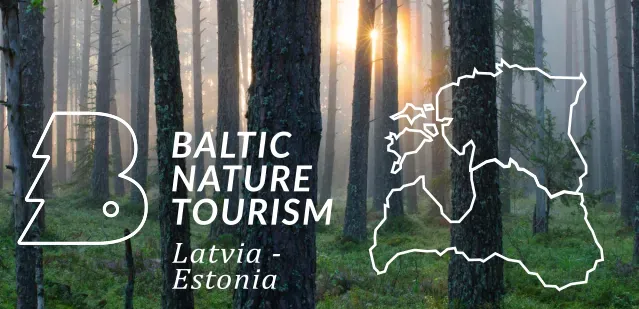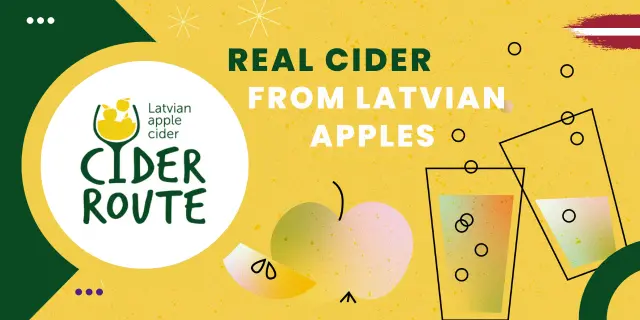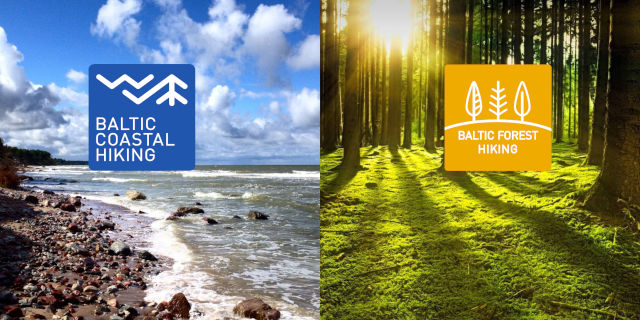Kontaktinformation
Related objects
| Foto | Name | Beschreibung |
|---|---|---|
|
Das einzige Baukomplex aus dem 17. – 18. Jh. solcher Art im Baltikum, entstanden an den Ufern eines kleinen Flusses. Stellenweise fließt der Fluss entlang den Hauswänden. Das lettische Venedig. |
||
|
Renda ist eine alte Ortschaft, die schon 1230 urkundlich erwähnt wurde. Im 13. Jahrhundert war Renda ein der Zentren der alten kurischen Staat Vanema. Nach einer Aufteilung von Kursa im Jahre 1235 war der Bezirk von Kursa ein Eigentum des deutschen Ordens und die Einwohner von Renda an die Kriegszüge des Ordens teilnehmen mussten. Während des Herzogtums von Kurland (1562 – 1795), abgesehen von Kriegen, der Pest und anderen Nöten entwickelte sich die Gegend, besonders während der Herrschaftszeit des Herzogs Jakob (1642 – 1682). Im 17. Jahrhundert wurde Renda zum entwickelten Manufakturzentrum, in dem sich Holzverarbeitung entwickelte, Kalkbrennöfen, Windmühle, Flachsspinnerei, Glasfabrik, Salpeterfabrik und Seifensiederei funktionierten. Hier wurde Wein, Parfümerieerzeugnisse, Fässer, Nagel und vieles andere hergestellt, sowie Roheisen gegossen wurde. Einen in Renda hergestellten säuerlichen Wein genossen im Schloss von Jelgava. Dieses Schloss wurde im Großen Nordischen Krieg (1700 – 1721) zerstört. Im 19. Jahrhundert wurde anstelle der verbrannten Burg von Renda eine Chemiestofffabrik gebaut, es funktionierte eine der größten Ledermanufakturen Kurlands und eine Terpentinherstellung. Parallel begann es ein Kulturleben sich zu entwickeln. Zwei Weltkriege des 20. Jahrhunderts und nachfolgende Repressionen haben die Bewohner von Renda nicht verschont. Demzufolge hat sich ein sogenanntes Bataillon “Kurelieši” herausgebildet – die Waldbrüder, die gegen der Sowjetmacht kämpften. Heute ist Renda eine kleine und leise Siedlung, in der das Landgut von Lielrenda, die Kirche von Renda, die alte Grabanlage Teufelsboot (Velna laiva) neben dem Fluss Abava und das Wasserfall des Flüsschens Īvande zu besichtigen sind. |
||
|
In der alten Getreidedarre des Landgutes von Alsunga befindet sich ein Souvenirgeschäft, in dem man Souvenirs und im Haushalt nützliche Dinge kaufen kann, die in dem Kreis von Suiti hergestellt sind: Tücher (die Kleidung von Suiti zeichnet sich durch lebhafte Farben aus), Handschuhe, Socken, Geschirr, Tees u.a. Hier werden kreative Werkstätte organisiert. |
||
|
Die bedeutendste Periode der Stadt ist mit der Zeit von 1561 bis 1795 verbunden, als der Kreis von Jelgava dem Herzogtum von Kurland und Semgallen gehörte. Als Jelgava zur Residenz des Herzogs (1567) und zur Hauptstadt des Herzogtums (1616) wurde, blühte die Stadt schnell auf. Der höchste Punkt der Entwicklung war in der Regierungszeit des Herzogs Jacob. In der Regierungszeit der letzten zwei Herzoge – Ernst Johann von Biron und seines Sohnes Peters – wurde die Academia Petrina (1775) – die erste Hochschule in Lettland – gegründet, im Jahr 1816 wurde die Gesellschaft für Literatur und Kunst gegründet, im Jahr 1822 wurde die erste lettische Zeitung Latviešu Avīzes veröffentlicht, im Jahr 1802 wurde das erste Theatergebäude, aber im Jahr 1898 – das erste Museumsgebäude in Lettland gebaut. Im Jahr 1937 zog im Schloss von Jelgava die Lettische Landwirtschaftskammer ein, aber in zwei Jahren wurde die Landwirtschaftliche Akademie von Jelgava geöffnet. Im Sommer 1944 wurden fast die ganze historische Bebauung und die Kunstwerte der Stadt zerstört. Nach dem Zweiten Weltkrieg wurde Jelgava erneuert. Vor einer kurzen Zeit wurde auch der Turm der Heiligen Dreieinigkeitskirche erneuert, wo zurzeit eines der besten interaktiven Museen in Lettland (kinder- und familienfreundlich) eingerichtet ist. |
||
|
Der Hof befindet sich an einem sehr schönen Ort am Westhang der Hügel um Talsi, von wo aus sich die Sicht nach Talsi und Umgebung eröffnet. Hier werden Äpfel angebaut und verarbeitet (getrocknet, Apfelchips, Saft). Auf die Gäste wartet eine Führung, bei der man die Produkte verkosten und erwerben kann. Der Hof befindet sich in einem besonders geschützten Gebiet, im Naturschutzpark Hügelland von Talsi. Im Sommer kann man hier auch mit Zelt campen. Die Besucher können zusehen, wie der Baumschnitt erfolgt. Aus den Gärten der Höfe in diesem Hügelland wurde eine Vielzahl an Apfelsorten gesammelt, woraus die Hausherrin die Kollektion einheimischer Äpfel erstellt und weiter vervollkommnet. Am Hof gibt es eine Schautafel, die mit dem NSG bekanntmacht. |
||
|
Most of the great tree’s mighty branches are gone, and among those that are still there, the thickest ones are held up by supports, and the tree’s hollow centre is protected against snow and rain with a little roof. This is the thickest Common Oak (Quercus robur) in Latvia and the Baltic States. Indeed, it is one of the thickest oak trees in all of Northern Europe. The tree is a gorgeous part of the surrounding landscape. There is a car park and an information stand nearby.
|
||
|
Auf einem Friedhof neben der lutherischen Kirche von Lestene sind mehr als 900 im Zweiten Weltkrieg gefallene Krieger umbestattet worden – vorwiegend die in der Kesselschlacht von Kurland auf dem Gelände von Semgallen und Zentral-Livland Gefallenen. Zum Andenken an die Krieger ist ein von der Bildhauerin Arta Dumpe errichtetes Denkmal “Mutter-Heimat – Lettland” aufgestellt worden. Der Brüderfriedhof von Lestene ist der zweitgrößte (nach dem Rigaer Brüderfriedhof) Bestattungsplatz Lettlands der im Zweiten Weltkrieg gefallenen lettischen Krieger. Auf den Grabsteinen sind die Namen von ~ 11 000 Krieger eingraviert. |
||
|
Der frühere Name von Jūrkalne war Felixberg, der übersetzt den glücklichen Berg bedeutet. Den heutigen Namen hat die Ortschaft im Jahr 1925 bekommen. Heute ist Jūrkalne nicht nur ein beliebter Ort von Touristen (die Steilküste von Jūrkalne), aber auch einer der seltenen Orte der Welt, wo man die Blauen Kühe besichtigen kann. |
||
|
Dieser Weinberg war schon in den Zeiten des Herzogtums Kurland als der Ort bekannt, wo so weit im Norden Weintrauben gezüchtet wurden. Hier werden sie immer noch gezüchtet, und aus den Weintrauben wird der säuerliche nordkurländische Wein hergestellt. Jährlich findet in Sabile in der zweiten Hälfte von Juli das Weinfest statt. |
||
|
Vom 16. Jh. bis 1920 war das Schloss Ēdole (deutsch: Edwahlen) im Besitz des Geschlechts derer von Behr. Nach einer Brandstiftung 1905 wurde das Schloss innerhalb von 2 Jahren wieder aufgebaut. Es ist bekannt für manche Spukgeschichten, wie etwa die einer Zwergenhochzeit, oder die eines Blutflecks im Roten Zimmer, der sich an der Stelle eines Mordes gezeigt habe. Um diesen zu verdecken, baute man an jener Stelle einen Kamin, aber der Fleck erschien wieder. Interieur, Säle und Keller des Schlosses sind erneuert und mit typischen Details ausgestattet. Die Räumlichkeiten sowie der Aussichtsturm sind Besuchern zugänglich. Im Park kann man die Allee der Liebe (Mīlestības aleja) und den Platz der Zwergeneiche (Rūķīšu ozola vieta) ansehen. |
||
|
Das Gehöft „Lūķi“ ist ein Ort in Jūrkalne, wo Sie in Ruhe in der Natur sein können. Sie können sich in den Cottages im Garten oder im großen Haus entspannen. Jeder Ort ist so gestaltet, dass sich die Gäste wohl und ungestört fühlen. Der Hof verfügt über eine gepflegte Landschaft mit großen Eichen, einem Teegarten, einer authentischen Sauna und Gartenhäusern. Es gibt auch einen Salon mit altem und modernem Kunsthandwerk. Der Bauernhof eignet sich für eine ruhige Erholung oder Familienfeier. |
||
|
Svete Bread *Object Inactive*
|
In dem mit Holz geheizten Backofen wird Brot nach alten Rezepten aus lokalen Zutaten (ohne GMO!) gebacken, ebenfalls Plätzchen und andere Leckereien. Kleine Gruppen können Führungen zu den Geheimnissen des Brotbackens buchen, Backwaren verkosten und erwerben. |
|
|
Opposite the tower of the Church of the Holy Trinity, the monument was designed by Arta Dumpe and commemorates Latvia’s first president, Jānis Čakste (1859-1927). It was consecrated on November 14, 2003, precisely 81 years after the statesman was elected to the important position. |
||
|
Ziednica *Object Inactive*
|
This is a pergola that is owned by Līga Reitere, who offers medicinal grasses and saunas for adults and children. She will show you how to tie together sauna switches, fire up the oven in the sauna and create steam inside it. You can also learn how wild plants can be used for tasty teas or salads, as well as to weave lovely crowns or grass carpets. Master classes, creative activities, educational seminars, evening sessions and sauna sessions are all available, with Līga also being well informed about local linguistic issues and traditions. |
|
|
Das Landgutsensemble in Milzkalne am Ufer des Flüsschens Slocene begann sich im 15. Jahrhundert zu bilden als einen geschlossenen Komplex fränkischen Typs für die Wirtschaftsbedürfnisse des Ordens und ist heutzutage ein einzelnes erhaltenes Beispiel eines befestigten Landguts solchen Typs (als ein Versteck für Gutsbesitzer im Angriffsfall) in Lettland. Am Ende des 17. Jahrhunderts wurden Tortürme mit den herrschaftlichen Flügeln, aber in den 18 – 19 Jahrhunderten – auch die Wirtschaftsgebäude errichtet. Von der ursprünglichen Bebauung ist eine Mauer mit den Schießöffnungen erhalten geblieben. In einem der Flügel des Komplexes wurde das Straßenbaumuseum Lettlands eingerichtet. In einem Hauptgebäude des Landguts befindet sich ein Hotel, hier werden Exkursionen und Verkostungen von Landerzeugnissen angeboten. |
||
|
Als Treuegabe Herzog Jakob Kettlers an den polnischen König war das Gotteshaus von1640-1642 erbaut worden. In diesem ist unter anderem ein Beichtstuhl mit allegorischen Malereien (1691) erhalten, drei Altäre mit Schnitzereien im Rokoko-Stil und eine Skulptur “Madonna mit dem Kinde” aus dem 16.Jh.. Nach vorheriger Anmeldung kann die Kirche auch von innen besichtigt werden. |
||
|
Erzählung über die Geschichte der Schokolade. Kennenlernen eines Herstellungsprozesses, Kreativwerkstätte. Ein kleines Geschäft. |
||
|
Der Turm wurde am 27. Juni 1941 in der Zeit eines Luftangriffes der sowjetischen Armee zerstört und 1954 von den Sappeuren der Sowjetarmee in die Luft gesprengt. Die Renovierung der gebliebenen Reste des Turmes hat 2009 angefangen. Im erneuerten Turm ist ein schönes interaktives Museum (Kinderfreundlich), ein Besucherzentrum und einne Glassaussichtsplattform eingerichtet. Ein Restaurant. |
||
|
Das heute zu sehende Gebäude im späten Barokstil und frühem Klassizismus, enstand auf die Initiative von Herzog Peter Biron von Kurland und Semgallen nach Plänen des dänischen Architekten Severin Jensen an der Stelle, an der sich das Schloss der Herzogin Anna befunden hatte. 1775 wurde hier die erste lettische Hochschule gegründet, die Academia Petrina, und 1782 wurde das erste Observatorium errichtet. Zur Zeit des russischen Imperiums befand sich hier ein Gymnasium. Zu dessen Absolventen gehören Krišjānis Barons (der berühmte lettische Volksliedersammler), Juris Alunāns (der Begründer der lettischen Sprachwissenschaft), Jānis Čakste (der erste Präsident des neugegründeten lettischen Staates), Antanas Smetona (litauischer Staatspresident) und andere mehr. 1952 wurde in diesem Haus das Museum für Geschichte und Kunst Jelgava eingerichtet, 1975 erhielt es den Namen des Malers Ģederts Eliass (1887-1975). Die Sammlung des Museums zeigt die Geschichte der Stadt und ihrer Umgebung zur Zeit des Herzogtums Kurland und Semgallen und danach. Neben dem eindrucksvollen Gebäude sind vier Kanonen aus der Zeit des Herzogtums Kurland aufgestellt, ein Denkmal, das Ģederts Eliass gewidmet ist, (1987. Künstler: Jānis Zariņš), sowie eine Skulptur des Bildhauers Kārlis Jansons (restauriert durch dessen Sohn Andrejs Jansons), das den Befreiern der Stadt Jelgava gewidmet ist. Es stellt ein Fragment aus einem lettischen Heldenepos dar und trägt den Namen “Lāčplēsis und der schwarze Ritter”. |
||
|
Die einzige Stelle in Lettland, an der man alte Orgeln erneuert und neue Orgeln, sowie die Drehorgeln baut. Die Meister erzählen den interessierten Gruppen über die Geschichte des Orgelbaus, die Prinzipien, einen Wirkmechanismus der Musikinstrumente. Die Werkstatt wurde 2004 in einem ehemaligen Stall des Pastorats eingerichtet. Der Besitzer und Leiter der Werkstatt ist Jānis Kalniņš. |
||
|
Eine erste Holzkirche wurde an dieser Stelle1252 errichtet, ein steinernes Gotteshaus wurde 1665 erbaut. Diese fiel einem Brand zum Opfer, wurde aber 1672 erneuert, in späteren Jahren auch umgebaut. Bedeutende Baudenkmäler zieren das Interieur des Gotteshauses – ein Altar, eine Kanzel, eine Orgel mit Malereien auf dem Prospekt und dem Balkon. In der Kirche ist der legendäre Herzog Jakob Kettler getauft, hier heiratete er Prinzessin Charlotte Luise von Brandenburg. In der Sowjetzeit wurde die Kirche nur als Museum und Konzertsaal genutzt. Der Legende nach hat die Kirche ihren Namen nach einer gewissen Katharina erhalten, die Spenden für den Bau der Kirche gegeben habe, dann verleumdet und zum Tod auf dem Folterrad verurteilt worden sei und später heilig gesprochen wurde. Zu ihrem Gedenken gibt es über dem Seiteneingang der Kirche ein Medallion, mit ihrem Abbild mit Märtyrerkrone, dem Folterrad und einem Schwert in der Hand. Motive dieser Legende sind auch im Wappen der Stadt Kuldiga zu erkennen. Vom Kirchturm hat man einen guten Blick auf die Ziegeldächer der Altstadt. |
||
|
Die Ordensburg Jaunpils, gebaut im Jahre 1301, hat ursprüngliches Aussehen bis heute erhalten. Die Burg bietet den Gästen eine Erholung in schönen Appartements des Barons oder in einfacheren Zimmern an. In einem mittelalterlichen Wirtshaus der Burg kann man mittelalterliche Gerichte sowohl mit Holzlöffel als auch mit Händen essen. Es werden Exkursionen und verschiedene mittelalterliche Aktivitäten angeboten.
|
||
|
Der Bauernhof „Caunītes“, ein Ort, der alle einläd, die eine lettische Atmosphäre und Gesellschaft genießen wollen.Als sie diesen Hof einrichteten, verfolgten die Besitzer das Ziel, eine Verbindung von traditionellem und modernem lettischen Milieu zu schaffen. Das Zentrum des Bauernhofes ist derzeit die Scheune mit einem Brotofen. Es werden verschiedene Aktivitäten der entsprechenden Jahreszeit angeboten, unter anderem auch Bildungsveranstaltungen. Zu einem Besuch muss man sich vorher anmelden! |
||
|
Geidas *Object Inactive*
|
The farm specialises in dairy farming. Students and others can go on an educational tour, “The Route of Milk,” during which they will be able to churn butter and learn about how dairy products are produced. |
|
|
Piltene is one of the smallest and oldest cities in Latvia, first mentioned in 1295, and being granted the rights of a city in 1557. Between the 14th and 16th century, Piltene was the administrative centre for the Bishopric of Kurzeme. The historical streets that surround the castle ruins feature wooden buildings from the first half of the 19th century. The bishop’s castle in Piltene was built at the turn of the 14th century and used until the 16th century. Only its foundations and fragments of its tower on the banks of the Vecventa River survive. |
||
|
The birthplace of Latvia’s first prime minister and, later, president, Kārlis Ulmanis (1877-1942) was turned into a museum in 1993. The homestead has undergone unbelievable transformation during the past two decades. The landscape has been cleaned up, and buildings that were lost or were in poor shape have been rebuilt. There are a house, an ancillary building, a cattle shed and barn and a granary. The exhibition focuses on the life of Ulmanis, featuring an impressive collection of agricultural equipment and instruments, including Latvia’s largest wooden butter churn. |
||
|
The first stone castle in Alsunga was built in 1372, starting with the central part of the southern wing. The authorised representative of the Livonian Order, who was subject to a higher-ranking official in Kuldīga, lived here. The guard towers and other parts of the castle were gradually added between the 15th and the 18th century. The Baroque castle with its two towers is quite impressive. The castle is unique in and outside of Latvia in that it is one of the rare Medieval castles to have survived to the present day in part, but in its original historical appearance. The castle offers an exhibition about its history. Visitors can look at a Suiti kitchen, write a letter with a fountain pen in Barbara’s boudoir, or celebrate a special event in the romantic venue of the castle’s round tower. Renovation of the castle began in 2018, and it is closed to visitors. Still, you can look at its exterior and tour its garden. |
||
|
Dobele name in historical sources for the first time is mentioned in1254. Dobele was one of the most fortified Semigallian places; therefore from 1279 until 1289 it survived six attacks by German crusaders. In 1289 Semigallians was forced to retreat. In 1335 conquerors instead of Semigallian castle began construction of new - stone castle. On the opposite shore of Berze - on the left bank merchants and craftsmen village began to form. Town suffered greatly during the Northern War and during the subsequent plague. A significant event in the economic life was the 1927, when Liepaja-Gludas railway line was built. After World War II in Dobele and its vicinity came to the Soviet militaries, who built one of the largest Soviet tanks range "Dobele-2". Now Dobele travellers are offered a range of interesting sites to be visited. |
||
|
The Buse (Matkule) castle hill is near the Imula River. From the castle hill and from the opposite shore of the river, you can find one of the loveliest views of Kurzeme’s small rivers. Their appearance is best when trees and other flora are bare and the view is unimpeded. A wonderful view of the Imula valley is also seen on the road to the castle hill – near the Buse homestead.
|
||
|
Adults and children will be able to learn about farm animals, view a collection of ancient tools, enjoy a country sauna with birch and juniper switches, drink herbal tea with honey, and taste carrot buns. During the summer, accommodations are offered in the granary or on the second level of the sauna. |
||
|
The Jelgava Castle stands between the Lielupe and Driksa rivers. The Baroque castle was designed by the well known Italian architect Francesco Bartolomeo Rastrelli, and this was the most important piece of early work that he did. The Latvian Agriculture University is housed in the castle today. A museum was established in 1968. +371-6300-5617. The socle story of the south-eastern wing has the graves of rulers from the Duchy of Courland – members of the Kettler and Byron dynasties, which ruled from 1569 to 1791. There are 18 restored sarcophagi here. |
||
|
This path is found on the right bank of the ancient Abava river valley. The visitor will be able to view places where underground streams create wetlands, various kinds of meadows, a stand of juniper bushes, etc. The area is “managed” all year long by “wild” cows. The shore of the ancient valley can be climbed (some 200 steps), and the view is magnificent. It is recommended that the trail be visited in the company of a knowledgeable guide. There is a shorter path that is 600m long, along with a longer one that is more than a kilometre in length. It will take an hour or so to traverse it. Objects are found in the ancient Abava valley nature park.
|
||
|
The square structure with walls that are nearly two metres thick became known as the Gunpowder Tower during the rule of Duke Jacob, because that is what was stored here. There might have been a well here, because groundwater is close to the surface. The tower and the castle were linked by a 12-metre bridge on one pillar. The tower is only visible from the outside. |
||
|
The open-air museum was proposed in 1992 by the sculptor Ojārs Arvīds Feldbergs, and it is located on the banks of the Ancient Abava River valley and on land that was once part of the Firkspedvāle and Briņķpedvāle estates. The park features contemporary art, and the museum also organises symposiums, creative workshops and other events. |
||
|
Tukums in the historical sources is mentioned in 1253 agreement of the Livonian Order and the Bishop on the division of Kursa. If the town's name is translated from the Liv language, it means "a pile, mountains of sand". at the beginning of 14th century German merchants and craftsmen settlement was formed at the Livonian Order stone castle, whose flowering was facilitated by the proximity of Riga - Prussian road. Later the city was largely influenced by the construction of Riga - Tukums railway in1877. During the Soviet period the on the eastern outskirts of Tukums, the largest Soviet military airfield and military town in the Baltic States was deployed. Today Tukums is a district centre of the same name with a wide range of services offered to tourists. |
||
|
This tavern is in the centre of Alsunga, which is the capital of the Suiti people. The Suiti have always known how to work hard, sing well and eat tasty foods. The tavern offers for tour groups to taste a delicious Suiti meal made from ancient recipes, after which participants can learn how to cook those foods – carrot buns, soured porridge and other masterful dishes from this part of Latvia. A very effective performance by Women of Suiti will make the meal truly unforgettable. You’ll also be able to purchase carrot buns and sourdough bread that is baked only here. Latvian cuisine: Sourdough bread, dumplings, dried ribs. Special foods: Homemade carrot buns. |
||
|
A country farmstead in vicinity of Valdeķi. A room for guests in the hosts' home. Guests can see farm animals. Country sauna with birch and juniper besoms, herb teas. Volley-ball grounds, 10 tent places. The owners have a large collection of old-time tools and can talk about how they were used at the farm. Families with children can help to take care of livestock in the evening (feed the animals, milk a goat, etc.) |
||
|
This little building is on the left bank of the Venta River beyond the ancient brick bridge. It is located at Pils Street 4. The hut was built in 1735, using rocks from the damaged castle of the duke, and it was built on a terrace that is the last fragment of the walls that surrounded the castle. Also known as the Hangman’s hut, the building was rebuilt during the 19th century. It can only be viewed from the outside. |
||
|
This is the widest water fall in Latvia – 249 metres wide and up to 1.75 metres high. This is an interesting natural, cultural and historical object in that it is linked to various events and legends. Duke Jacob of Courland invented equipment to catch fish. It was fastened to the cliffs of the waterfall, and this created the tale of a city where salmon and other fish who were leaping across the waterfall fell into the nets and were thus caught in the air. During Jacob’s rule, there was talk about digging a canal around the waterfall to ensure shipping, and work began on the project. During the early 18th century there was the idea that the Baltic Sea and the Black Sea could be connected via the Venta, Nemuna and Dnieper rivers. Turkish prisoners of war continued to dig the canal, but the local dolomite cliffs were a problem. Attempts to blow up the cliffs led to damage to nearby buildings, so the work ended. The impressive ditch can still be seen today. In 2012, a wooden pathway was installed on the right bank of the Venta to offer a good look at the waterfall. It is worth visiting here during various seasons of the year, when different types of fish migrate. |
||
|
has a permanent exhibition that features a Suiti living room and kitchen and liturgical apparel worn by Catholic priests. In the exhibition hall there are changing exhibitions related to the history and present of the Suiti Women ethnographic ensemble. A special offer involves performances by Suiti women, Suiti men and Suiti bagpipe players. Also in the building are the Alsunga Tourism Information Centre, as well as ceramics and weaving workshops. Contact the museum in advance to arrange for performances and master's classes. |
||
|
The church was opened in 1651 after half a century of sometimes interrupted construction. It was fully rebuilt and took on its current appearance in 1876. The church contains one of the most important church objects in Latvia – the oldest pulpit in the country (1590). It was designed in the style of Mannerism. The church also has a bell from a wrecked chapel of the local knighthood. The bell was manufacture in 1450 and was installed at the church in the 19th century. It is the oldest church bell in Latvia. The German painter F. Wolff painted the altar painting, “Christ on the Cross,” and it, along with the altar, have recently been restored. |
||
|
Found on the right bank of the Saka River at Dzintaru Street 1, the museum is in the first red brick and fieldstone building in Pāvilosta. It was built in 1879 for ship pilots. The museum focuses on the history of the local region, particularly in terms of fishing and seafaring. Among the exhibits are stone and bone axes, bronze brooches and belts, as well as a unique honey press, all of which have been found in the Saka Parish. Alongside the museum is a boathouse with larger exhibits. A mansard that was opened in 2012 is a site for exhibitions and thematic events. The museum’s phone number is +371-6349-8276. Make sure that you also visit the oldest part of Pāvilosta – Āķgals, which is a typical coastline village from the 19th and early 20th century. |
||
|
The Gardening Institute is the leading scholarly centre for fruit and vegetable research in Latvia. The institute specialises in selection and introduction of plant cultivars that are suitable for cultivation under the agro-climatic conditions in the Baltic countries, have high nutrition value and are rich in fibre content. |
||
|
The Old Town of Kandava is located around the old Market Square and dates back to 1881, after a fire in the town. The urban environment in Kandava is made up of farms with various buildings, closed yards, passageways and walls made of fieldstones. These can be seen in Talsu Street and Sabiles Street. Uncommon for Latvia is Lielā Street. At the foot of the Bruņinieku Castle Hill is a model of the Castle of the Livonian Order that was created in 2010. |
||
|
Kandava is first mentioned in the articles in 1230. In 1253 the Livonian Order built a stone castle at the upper part of Abava valley shore, at the foot which of an urban area formed. In the 17th century Kandava became an important trading centre. The plague epidemic and developments of World War I hit the town and its people hard. Kandava got the town rights in 1917. During soviet Soviet times, Sports Complex of Jaunkandavas agricultural Technical School became a popular training venue. |
||
|
The German order built a stone castle here in 1242, and only a few fragments of it remain along with a vaulted cellar in which local wines can be tasted if you register in advance. The castle of the Duke of Courland was here later, but it was destroyed during the Great Northern War in 1701. Reconstruction of the park involved wooden pathways and bridges, information stands, a pergola and a fountain. There are 22 sculptures in the park that are the work of Līvija Razevska. |
||
|
In the Berzini homestead they bake exceptionally tasty wheat and rye bread in accordance with the old folk recipes. The taste and smell is the result of baking bread in a special oven which is more than 70 years old. It is possible to order bread, or, having booked a visit beforehand, to make and bake your own bread loaf. The owners will teach you bread baking traditions and use recipes from their ancestors to bake loaves in a true bread oven. |
||
|
Documents show that the first windmill was built here in the 13th century along with the Kuldīga Castle. During the rule of Duke Jacob, gunpowder was manufactured at the windmill, and it later became the first place in Kurzeme where paper was manufactured. The building took on its current appearance during the 19th century. During the Soviet occupation, a metal processing workshop was in it. |
||
|
On the banks of the Venta River is a treasure of wooden architecture – the so-called Bangerts Villa, which relates to romantic stories and legends and was recently restored. It is said that a man known as Captain Bangerts bought the villa as a gift to present to his Parisian bride. The Kuldīga Administrative District Museum has been in the building since 1940. Since reconstruction, unique wall paintings and other interior design details have been restored, and the flat of the Bangerts family allows people to see how wealthy residents of the city lived in the early 20th century. Also on display are some of the sets of playing cards that have been collected by Jānis Mētra. |
||
|
3 km to the south of the centre of Jūrkalne, near the old (gravelled) road between Liepāja and Jūrkalne, is the place where the three-year Feliksberga Maritime School existed between 1871 and 1902. The building is long gone, and the memorial has involves an oaken boat with two wooden poles on which old ownership signs have been engraved. |
||
|
Das in dunklen Tönen gestrichene Gebäude wird im 17. Jh. erstmalig in Dokumenten erwähnt, in dessen Keller befand sich das erste Gefängnis der Stadt. Der historische Ratsplatz daneben war der wichtigste Treffpunkt und auch Strafvollzugsplatz, denn in der südöstlichen Ecke des Platzes gab es einen Pranger. Heute befindet sich hier das Touristeninformationszentrum und eine Weberwerkstadt. Hier kann man in Kurzeme hergestellte Waren und Souveniere erwerben, in der Werkstatt bei der Webearbeit zusehen. |




